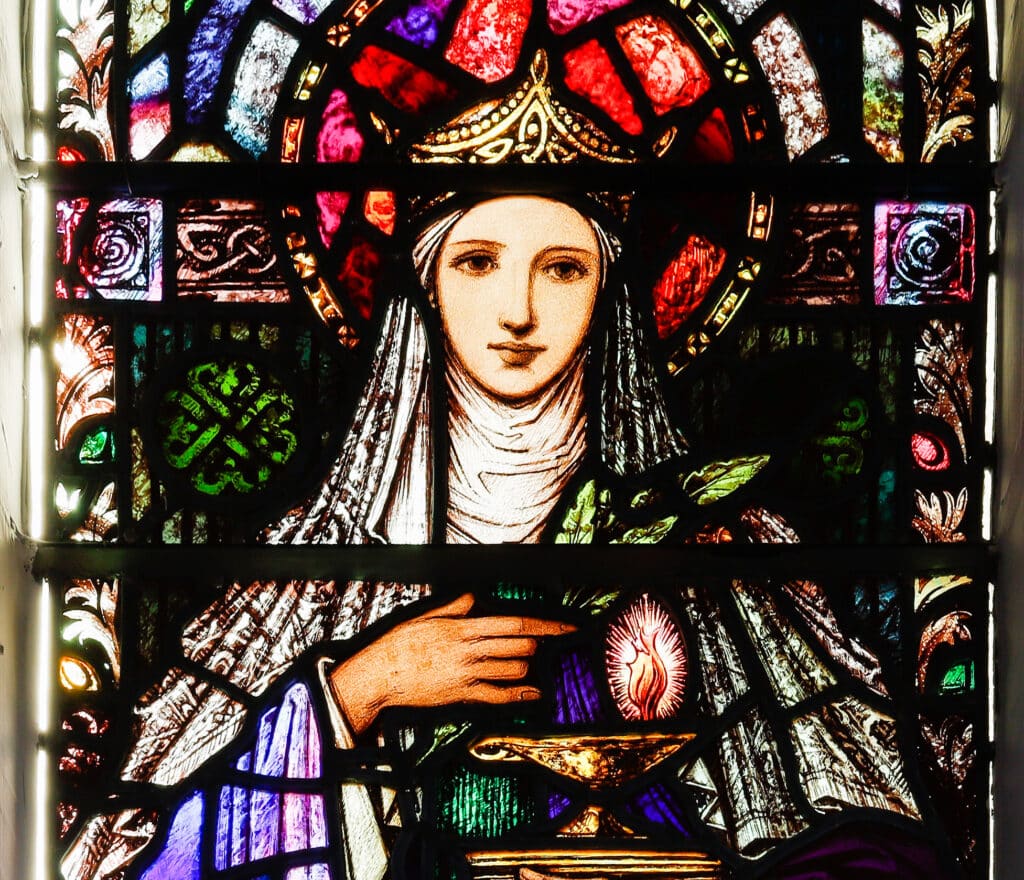
In Irish folk tradition, St. Brigid’s Day, February 1, is the first day of spring, and thus of the farming year. It is the festival of Ireland’s much-loved Brigid, who is often called ‘Mary of the Gael’. She built her convent in Kildare (Cill Dara, the Church of the Oak).
In pre-Christian Ireland, February the first was the feast of ‘Imbolc’ (‘Imbolg’ in modern Irish), which means ‘giving milk’, when sheep and cows began to lactate, and it also marked the quickening of the earth. St. Brigid’s Day marks the loosening of winter’s grip. Brigid, the bright maiden of spring, bringing light and new growth, takes over from the ‘Cailleach’, the hag of winter. To see a hedgehog on St. Brigid’s Day was a good weather sign, as the hedgehog comes out of his burrow, looks about to judge the weather and stays out if mild weather is coming. From Irish folklore we read: ‘St. Brigid was very generous and her feastday is an omen of good times to come. She ushers in a more plentiful season, for when her day comes, the ‘Dubhluachair’, or the darkest, severest part of the year, is gone. The ‘Dubhluachair’ is between Christmas and February 1. In this severe weather the rushes turn black.
Brigid shares her name with the goddess ‘Brigit’, who was honoured as the source of fertility, abundance, of all the aspects of nature. When Christianity became established, it Christianised many of the old festivals and gods of the old religions. Some of the aspects of everyday life that came under the patronage of both Brigit the goddess and Saint Brigid include smiths, the hearth, poets, midwifery and healing. As a Christian spiritual figure, she became associated with the ‘disempowered of humanity’, including the displaced, the impoverished, and the socially stigmatised people, such as disabled and illegitimate children.
Countless people bear her name; churches, convents and holy wells are called after her, not only here but in many other countries as well. She has from an early period been linked with the church in Kildare where she founded a convent and, as abbess, ruled over priests and nuns. Some scholars believe that Kildare itself had originally been a pagan sanctuary of the Celtic Goddess, Brigit. Then when Christianity came, a saintly woman bearing the same name as the goddess, took over the pagan sanctuary and turned it into a convent. Here in this part of West Cork, there are at least four holy wells named ‘Tobar Bríde’ (Brigid’s Well); these certainly are pre-Christian and were places of devotion before the coming of Christianity.
Much was written about Brigid from the seventh century on. Two fundamental ideas about her life are her great faith in God, and secondly, her extraordinary charity and love for others, both human and animal. She never allowed the poor to go away empty-handed. Much of her life story is concerned with domestic life and running a house and her miracles deal largely with the multiplication of food and drink and with healing.
The making of ‘Cros Bríde’ (St. Brigid’s Cross) was the most widespread custom connected with the festival. Woven from straw or rushes, they are diamond-shaped. It is still customary for children to make them in school. They were hung in the dwelling house and in the cattle byres as protection for the family and the animals. The most usual was the diamond shaped ones, made of straw, rushes or osiers. They can be seen today in many houses and are also a popular item in some shops catering for the tourist industry. The cross was hung in the house and also in the cow byre, to protect the family and the cattle. The cross was also considered to be a protective agent against storms, lightning and fire. Protection against fire was particularly important at a time when most houses had thatched roofs which were highly inflammable. There are many tales telling of how Brigid made the first cross. According to a story from Co. Clare, a certain woman disliked Brigid and wanted to kill her. Her chance came when Brigid visited her house. She bade Brigid welcome and offered her a drink of milk into which she had put some poison. Brigid, however, got a little straw and made the sign of the cross over the milk. She drank the milk and remained unharmed. The people heard of this miracle and began the custom of making crosses in honour of her, and hanging them up in their house.
A story from Co, Derry relates how Brigid had no food left in the house for her father’s meal as she had given everything to the poor. She prayed earnestly and made crosses from rushes and placed them in the cheese presses. Her father returned and found the presses full of cheese. This story places the emphasis not so much on protection from danger but rather on the plentiful supply of food for the household which St. Brigid guarantees to those who hang up her cross in their homes. St. Brigid’s Cross was the first logo of RTE but was replaced in 1995.


